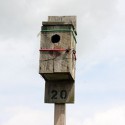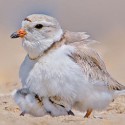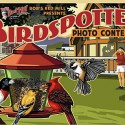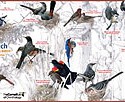 Photo ©
Keith Williams
Photo ©
Keith Williams

Bear-ly A Scratch
by Alice Droske, a NestWatcher, FeederWatcher, Great Backyard Bird Count participant, and Cornell Lab member for 25 years
June 24, 2013, started out like any other American Kestrel nest box monitoring day. I, along with Joe Palzkill and Judy Schwarzmeier (federally licensed banders), monitor 27 kestrel nest boxes for Beaver Creek Reserve in Fall Creek, Wisconsin. Jill Barland, our silent auction winner, was with us.
It was a beautiful warm day, and upon our arrival at Box 20, we expected to find 4 juvenile kestrels inside the nest box, which we were prepared to band. We had quite a shock! As we drove up, there was no nest box on the 10-foot pole. Our truck went deadly silent inside. We looked at each other and said, “Oh no.”
We jumped out of the truck and began searching the area for the nest box. We found the nest box broken and scattered in pieces on the ground beneath the pole. Just then, the farmer who had given us permission to place the box on his farmland drove past. I ran to the farmer and asked, “Have you seen a bear on your property?” He replied, “Yes. A rather large bear has been seen in the area.” We were fairly certain that a bear had ransacked our kestrel nest box.
We quickly began surveying the area under the nest box. To our surprise, on the ground hidden in the tall grass were the four juvenile kestrels! We assessed they had been on the ground for several days due to the amount of fecal matter and pellets. They remained quiet until Joe pushed the tall grass away from where they were huddled together. Once they were spotted, they became very noisy.
Judy began the process of aging, sexing, and banding the juvenile kestrels with Jill aiding her. Joe and I used the two ladders we carry in the truck and began repairing the nest box. We used multiple bungee cords and used the old screws to reattach the nest box on the pole. We then placed the four juveniles into the nest box, while the adult female kestrel flew overhead. Later that evening, we returned to the nest box to check that our repair work was holding up. The adult pair was flying to the nest box and dropping prey into the entrance hole. The parents continued to feed the young, and the four juvenile kestrels fledged successfully. At the end of the season, the old box was taken down, and a new box was installed. It was a happy ending to an exciting adventure for us all and an important reminder why we monitor our kestrel nest boxes so diligently.

Mockers Hit New Max
We are so excited to announce that we have officially set a new record for the number of Northern Mockingbird nest attempts submitted to NestWatch.org. We know that monitoring mockingbird nests probably involved a lot of scolding and dive-bombing (and midnight serenades) that you had to endure in the name of science, but their spunky attitude is part of the reason they’re so much fun to watch!
NestWatchers also crushed the record for Prothonotary Warbler nests this year! For the first time in history, we reached the elusive high-water mark of 200 nests for this species. This brings our total number of shattered records up to eight species this year.
But wait, there’s more! We are also beyond thrilled to announce that we have officially surpassed historic records for the total number of nesting attempts monitored in a single year: 17,146! And with just over a month left to go in the 2013 NestWatch season, there is still plenty of time left to submit your nest observations and break even more species records. (You’re next, Carolina Chickadee.) This accomplishment would not have been possible without all of the great work of NestWatchers like you! Help us get to 20,000 nesting attempts by the end of the year by submitting your nesting data at NestWatch.org today.

2013 NestWatch Pledge Drive
As Thanksgiving approaches and flocks of Wild Turkeys strut through Sapsucker Woods, comically inflated like parade floats jousting for position, we have to reflect on everything that NestWatch has to be thankful for this year. NestWatch simply would not be possible without the support of people like you who generously give their time, energy, and funds to keep the program going. In 2013, with your help, we were able to:
- describe the first occurrence of twin Eastern Bluebirds ever recorded (now being prepared for publication in a scientific journal);
- reach 10,000 new people with our beautiful new NestWatch Pocket Guides. (Bonus: all species featured within it had a record-breaking year of submissions.);
- and enroll 5 new NestWatch chapters, which together with the 26 inaugural chapters, trained a total of 528 new NestWatchers.
We recently asked for your help to continue these successes into 2014, and many of you have responded, bringing us to 75% of our goal of raising $4,000 by December 31. Thank you for your support! We hope you’ll continue to share your appreciation of NestWatch with others.
If you have not yet responded, please consider making a contribution to NestWatch today, and help us keep this free, fun, and informative program growing. For donations of $25 or more, you will receive a beautiful NestWatch poster, and if your gift is received by December 10, we guarantee the delivery of posters by Christmas Eve. They make a good holiday gift for birdy friends, family members, or educators on your list, especially when paired with a nest box.

BirdSpotter is Back—Grab Your Camera and Win!
Project FeederWatch and Bob’s Red Mill Natural Foods are teaming up for the second annual BirdSpotter photo contest. Participating is as easy as point-and-shoot. Just take photos of the birds that visit your feeders and post them on the contest web page at FeederWatch.org/birdspotter2013.
Voting on the web page will decide the weekly winners, with prizes such as a Cornell Lab sapsucker camera strap and a bag of Bob’s Red Mill steel cut oats. The contest runs from November through February, with a grand-prize winner receiving a trip for two to Oregon for three nights, a mill tour from Bob, and fantastic birding with Northwesterners.

Monthly Winner
At the beginning of each month, NestWatch randomly selects one participant who has entered data that month to receive a copy of the NestWatch Common Nesting Birds of North America poster. This month’s lucky winner is Clarence Davis. Congratulations, Clarence!